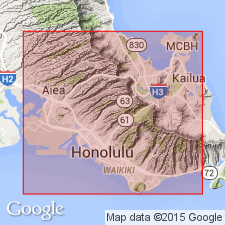
- Usage in publication:
-
- Diamond Head tuff
- Modifications:
-
- Original reference
- Dominant lithology:
-
- Tuff
- AAPG geologic province:
-
- Oahu
Summary:
[Pg. 40-43.] Diamond Head tuff. Tuff, 1 to 5 feet thick, forming Diamond Head, Island of Oahu, Hawaii. Rests on weathered gravel composed of cobbles of Koolau basalt. Overlain by Kaimuki basalt, 4 to 9 feet thick. [Age is late Pleistocene.]
Source: US geologic names lexicon (USGS Bull. 896, p. 607).
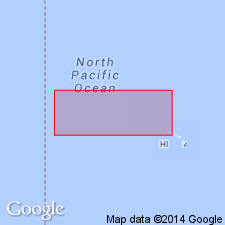
- Usage in publication:
-
- Diamond Head tuff*
- Modifications:
-
- Principal reference
- Revised
- Biostratigraphic dating
- AAPG geologic province:
-
- Oahu
Summary:
Diamond Head tuff. Cone consists of beds of palagonitized subaerial brown tuff containing much accessory and accidental ejecta, including appreciable amounts of reef limestone and occasional fragments of Koolau basalt. Contains vegetation molds and carbonized remains of land plants including myrtaceous plant resembling EUGENIA (SYZYGIUM SANDWICENSE). Magma is nepheline basalt. Included in middle part of Honolulu volcanic series [q.v.]. Underlies Kaimuki basalt in Kapakulu Quarry and Black Point basalt near Kupikipikio Point (Black Point). Presence of fossil plant remains and fact that unit rests on massive limestone reef 20 feet above sea level indicates eruption during Waipio stand of sea (middle? and late Pleistocene). [Age is considered late Pleistocene.]
Type locality: Diamond Head cone, [Diamond Head State Monument area, approx. Lat. 21 deg. 15 min. 47 sec. N., Long. 157 deg. 48 min. 53 sec. W., Honolulu 7.5-min quadrangle, Honolulu Co.], Island of Oahu, HI.
[Lat./Long. coords. from GNU records (USGS DDS-6; Menlo GNULEX, compiled September, 1988).]
Source: US geologic names lexicon (USGS Bull. 896, p. 607); GNU records (USGS DDS-6; Menlo GNULEX).
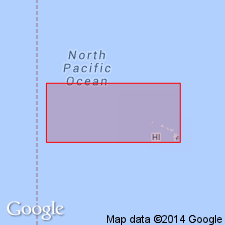
- Usage in publication:
-
- Diamond Head tuff*
- Modifications:
-
- Age modified
- AAPG geologic province:
-
- Oahu
Summary:
Pg. 80-81. Diamond Head tuff. Palagonitized subaerial brown tuff containing many accessory and accidental ejecta including many fragments of reef limestone and some of Koolau basalt. Magma is nepheline basalt. Thickness about 900 feet. Rests on reef limestone believed to have been formed during plus 95-foot (Kaena) stand of sea; overlain locally by beach limestone of plus 25-foot (Waimanalo) stand. Overlain by Kaimuki and Black Point basalts. Age is considered late Pleistocene, based on stratigraphic relations and fossil plant remains.
Covers about 1.3 sq mi on south coast of Island of Oahu about 10 mi west of Makapuu Head.
Source: US geologic names lexicon (USGS Bull. 1200, p. 1112); supplemental information from GNU records (USGS DDS-6; Menlo GNULEX).
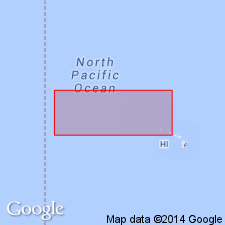
- Usage in publication:
-
- Diamond Head Tuff*
- Modifications:
-
- Geochronologic dating
- AAPG geologic province:
-
- Oahu
Summary:
K-Ar age of overlying Black Point Basalt is 0.48 +/-0.08 Ma and of coral from underlying Kaena Limestone is 0.6 +/-0.1 Ma.
Source: GNU records (USGS DDS-6; Menlo GNULEX).
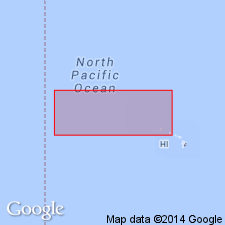
- Usage in publication:
-
- Diamond Head Tuff*
- Modifications:
-
- Age modified
- AAPG geologic province:
-
- Oahu
Summary:
Diamond Head ... "is a nepheline basanite tuff cone of the Honolulu Formation, roughly 500,000 years in age." p.78. "At Kaikou Place, the tuff is overlain by the Black Point nepheline basanite flow dated at 480,000 +/-80,000 years (Lanphere and Dalrymple (1980)." p.79
Source: GNU records (USGS DDS-6; Menlo GNULEX).
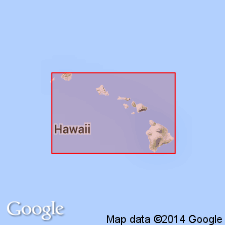
- Usage in publication:
-
- Diamond Head tuff cone†
- Modifications:
-
- Abandoned
- AAPG geologic province:
-
- Oahu
Summary:
Diamond Head Tuff (Wentworth, 1926), Diamond Head Black Ash (Wentworth, 1937), and Black Point Ash (Stearns, 1940) abandoned as formally named units and called Diamond Head tuff cone, informal unit in Honolulu Volcanics.
Source: GNU records (USGS DDS-6; Menlo GNULEX).
For more information, please contact Nancy Stamm, Geologic Names Committee Secretary.
Asterisk (*) indicates published by U.S. Geological Survey authors.
"No current usage" (†) implies that a name has been abandoned or has fallen into disuse. Former usage and, if known, replacement name given in parentheses ( ).
Slash (/) indicates name conflicts with nomenclatural guidelines (CSN, 1933; ACSN, 1961, 1970; NACSN, 1983, 2005, 2021). May be explained within brackets ([ ]).

